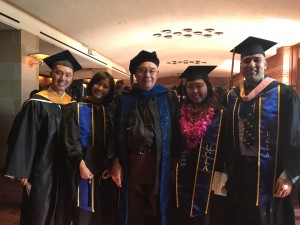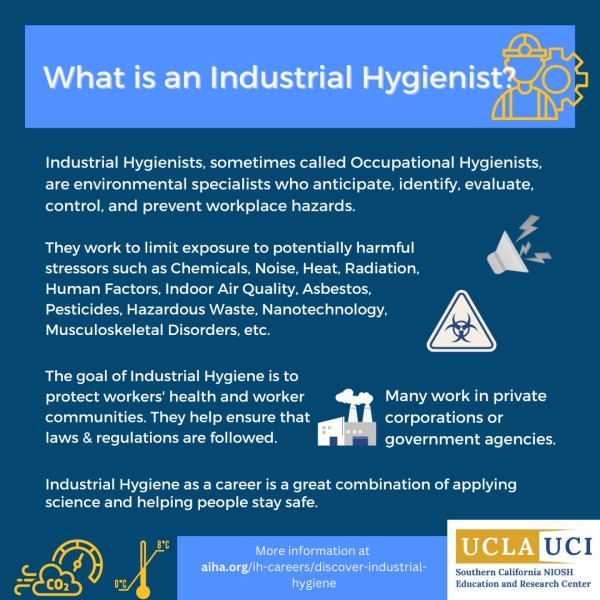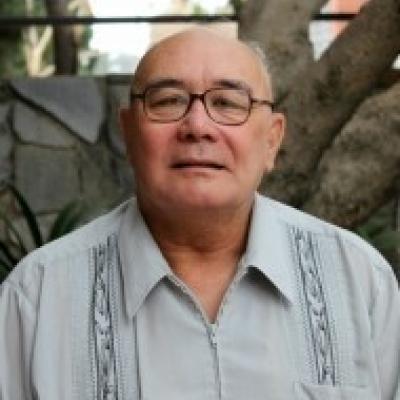
What is an industrial hygienist?
Industrial hygienists are environmental specialists concerned with anticipation, identification, evaluation, control, and prevention of exposure to potentially dangerous and hazardous chemical, physical, biological, mechanical, psychosocial, and ergonomic stressors in the workplace environment. They provide insight into these problems based on their knowledge of the adverse health effects of exposure to the agents involved; on their expertise in recognizing, evaluating, measuring, and controlling hazards and on their application of the physics, chemistry and social/managerial determinants of the workplace environment. They also often work as part of interdisciplinary teams with epidemiologists, physicians, nurses and toxicologists.
Program
The primary academic objective of the UCLA Industrial Hygiene Program is the training of professional and research industrial hygienists at the Masters and Doctoral levels. The Master of Science (MS) and the Master of Public Health (MPH) programs are two-year programs within the Department of Environmental Health Sciences in the Fielding School of Public Health. The program produces scientifically sophisticated graduates capable of performing at an advanced professional level and of moving into leadership positions. Training includes classroom/remote instruction, laboratory exercises, field trips, reports, internships, interdisciplinary interactions, and research.
The degree curricula include courses covering the properties, health effects, exposure prevention, exposure measurement, regulations and guidelines, and control technologies for all types of harmful chemical, physical, biological, mechanical, psychosocial, and ergonomic stressors. There are required in-depth courses on environmental health fundamentals, toxicology, biostatistics, epidemiology, interdisciplinary practices, aerosols, gases and vapors, ventilation and other controls, occupational safety, physical agents, workplace walkthroughs, from the occupational and environmental health perspectives.
All graduate (Masters and Doctoral) students must also choose 4 elective units from a list of five areas of industrial hygiene focus: Hazardous and Emerging Technology Substances; Human Toxicology; Industrial Hygiene Chemistry; Industrial Hygiene Management/Policy; and Safety. PH 201 must be taken if no introductory public health course has been previously completed.
The MS program includes a research-based thesis or report/exam. The MPH program includes a summer internship in industry or related area. The internship is optional for MS candidates. EHS 101 in chemistry must also be passed if its entrance examination is failed.
The PhD program provides advanced training in a research area of industrial hygiene through the Doctor of Philosophy degree of the Department of Environmental Health Sciences. The PhD program includes a research thesis dissertation that contains materials for two to three or more papers publishable in peer-reviewed academic journals, as well as presentations of this research at the appropriate disciplinary venues. The required courses are those of the Fielding School of Public Health, the EHS Department, and EHS 201 if a course in public health has not been previously completed. PhD candidates must also do the research area specialty courses set by their Guidance Committees. Superfund trainees must also take EHS 258 and EHS 280 as specialty course requirements.
| YEAR | SESSION | ||
| FALL | WINTER | SPRING | |
| 1. EHS 230A Interdisciplinary Occupational Health Practice | 1. EHS 230B Interdisciplinary Occupational Health Practice | 1. EHS 230C Interdisciplinary Occupational Health Practice | |
| 2. BIO 100A Introduction to Biostatistics (MS) or PH120A Fundamentals of Public Health (MPH) | 2. BIO 100B Introduction to Biostatistics | 2. EHS 240 Fundamentals of Toxicology | |
| 1 | 3. EHS C200A Foundations of Environmental Health Sciences | 3. EHS 252D Properties & Measurement of Airborne Particles | 3. EHS C200C Foundations of Environmental Health Sciences |
| 4. EHS M411 Environmental Health Sciences Seminar | 4. PH200B Fundamentals of Public Health (MPH) | 4. EHS 252E Identification & Measurement of Gases & Vapors | |
| 5. EPI 100 Principles of Epidemiology | |||
| 1. EHS 230A Interdisciplinary Occupational Health Practice | 1. EHS 230B Interdisciplinary Occupational Health Practice | 1. EHS 200D Policy Analysis for Environmental Health Sciences | |
| 2. 2. EHS 255 Control of Airborne Contaminants in Industry | 2. EHS 253A Physical Agents | 2. EHS 230C Interdisciplinary Occupational Health Practice | |
| 2 | 3. EHS 259B Workplace Safety | 3. EHS 253B Physical Agents Laboratory | 3. EHS C257 Risk Assessment and Standard Setting |
| 4. . EHS 596/598 Master’s Thesis Research (MS) or PH 401 Interprofessional Education, Leadership, Training, & Professional Development Health Sciences Collaboration (MPH) and EHS 400 Internship (MPH). | 4. EHS 410A Instrumental Methods in Environmental Sciences (MS) | 4. EHS 259A Occupational Safety and Ergonomics | |
| 5. EHS 454 Health Hazards of Industrial Processes | 5. EHS 596/598 Master’s Thesis Research (MS) or EHS 400 (Internship) | ||
| 6. EHS 596/598 Master’s Thesis Research (MS) or EHS 400 Internship (MPH) |
EHS 252G Industrial and Environmental Hygiene Assessment is required in Spring Quarter of the 2nd year if no field sampling in gases & vapors, aerosols, noise, and heat has been done previously. One of the following must also be taken if a basic course in Public Health has not been passed: a). PH150, Contemporary Public Health Issues; b). HPM M242: Determinants of Health; c). 6 Grand Rounds presentations over 2 years.
The MPH Program is the same as that given for the MS Program except that BIO100A, EHS 596/598, EHS 410A, EPI100 and the introductory lectures/course in Public Health are not required and the following are required:
- EHS 400 Field Studies in Env. Health Sciences (register when finished)PH200A PH200A Foundations in Public Health (F, 1st year)
- PH200A Foundations in Public Health (W, 1st year)
- PHC201 Fundamentals in Public Health (F, 2ND year)
| Year | Session | ||
| FALL | Winter | Spring | |
| EHS 230A,B,C Interdisciplinary Occupational Health Practice | EHS 230A,B,C Interdisciplinary Occupational Health Practice | EHS 230A,B,C Interdisciplinary Occupational Health Practice | |
| BIO 100A Introduction to Biostatistics | BIO 100B Introduction to Biostatistics | EHS 252D Properties & Measurement of Airborne Particles (S) | |
| 1 | EHS C200B Foundations of Environmental Health Sciences | EHS C200C Foundations of Environmental Health Sciences | EHS 252E Identification & Measurement of Gases & Vapors (S) |
| EHS 411 Environmental Health Sciences Seminar | EPI 100 Principles of Epidemiology | EHS 252F Industrial Hygiene Measurements Laboratory (S) |
EHS 252G Industrial and Environmental Hygiene Assessment is required in Spring Quarter of the 2nd year if no field sampling in gases & vapors, aerosols, noise, and heat has been done previously. If entering MPH candidates do not pass the EHS101 Entrance Examination, they must also do and pass EHS 101 Fundamentals of Chemistry in Environmental Health in the Fall Quarter of entry
The EHS400 Internship is performed usually during the Summer of 1st year but students only register once they are finished their field work. Placement and documentation are organized by the EHS Department Coordinator. Logistics are explained in the Internship Handbook.
The PhD part of the IH program follows the required courses of the Department and the Fielding School of Public Health plus those selected in the IH specialization by the student’s Guidance Committee as set out in the Department of Environmental Health Sciences PhD Handbook on student entry. An IH Academic Senate faculty member must be willing to accept an applicant.
After doing the required and specialization courses, the candidate needs to pass a Written Qualifying Examination, an Oral Qualifying Examination, and then after the research is finished that produces the equivalent of two to three journal papers defends the dissertation.
The PhD required courses, in additon to core required courses, are:
- EHS C200C (6 units, Spring1): Foundations of Environmental Health Sciences
- EHS 296: Research Topics in EHS (2 units, required for each quarter in residence)
- EHS 411: Environmental Health Sciences Seminar: (4 units, Fall-1,2)
- EHS 414A (2 units, Fall1) and EHS 414B (2 units, Spring1): Research Methods and Effective Communication in Environmental Health Sciences
- One full course in epidemiology (4 units or more at the 100 or 200 level)
- Public Health course requirement: Students who have not previously completed a Council on Education for Public Health (CEPH)-accredited degree (bachelor’s, master’s or doctoral degree) are required to complete Public Health 201: Fundamentals in Public Health
- SCERC Superfund doctoral students must complete EHS XXX Exposure & Health Effects Associated with Emerging Technologies (4 units) in Year 1, and EHS 258 Identification and Analysis of Hazardous Waste (4 units) in Year 2.
The educational objectives of the UCLA Industrial Hygiene Program are:
- To equip program graduates with the underlying technical and scientific knowledge required for the professional practice of industrial hygiene.
- To equip program graduates with specialized, practical, and experiential knowledge and skills necessary for the professional practice of industrial hygiene.
- To equip program graduates with the communication skills necessary for the professional practice of industrial hygiene.
- To impart to program graduates an appreciation of the need to work as part of an interdisciplinary team addressing occupational health problems.
- To instill in program graduates the understanding that the practice of industrial hygiene involves ongoing learning and self-criticism.
The UCLA Industrial Hygiene Program, led by Dr. Shane Que Hee, Director, and Dr. Tsai, Deputy Director, provides NIOSH traineeships for students intending to pursue careers in industrial hygiene. Support may be in the form of fees and/or stipend. Eligibility for an Industrial Hygiene traineeship is determined primarily by the student’s career objectives.
The NIEHS-funded Southern California Superfund Research Program (SCSRP) is an occupational health and safety education program that focuses on emerging and nano technologies. The SCSRP aims to provide professional training through research experiences, continuing education courses and academic curricula in industrial hygiene and environmental health sciences for graduate students and industrial hygienists in the Southern California region, and to recruit diverse undergraduate and graduate students to join the graduate school pursuing masters and doctoral studies in occupational and environmental health sciences related fields. Led by Dr. Tsai, the multidisciplinary team includes highly diverse faculty members at UCLA, UC Irvine and California State University, Fullerton.
To be eligible you must:
- Be a U.S. citizen or permanent resident immigrant (green card holder);
- Have as a career objective the field of industrial hygiene, broadly defined;
- Take (or waive) all the courses listed in the industrial hygiene model curriculum;
- Inform the program director of your type of employment for five years after graduation.
Note:
- Stipends are limited to eligible students working less than 50% time in off- and on-campus professional positions.
- Fees are limited to eligible students working less than full time in off-campus professional positions.
- Support for Masters students is typically limited to a maximum of 6 quarters.
- A first-year GPA of 3.0 or better is required for second-year support.
- A minimum of 12 units is required for every quarter in residence.
- The maximum NIOSH support time for a Doctoral student is five years.
Early in Winter Quarter of the 1st year, the IH Director distributes a contact list of potential internship offers based on past history. In the last 5 years, students have done internships with:
- The UCLA Environmental Health & Safety learning about stressor characterization at a major university. Projects included studying ventilation of empty and occupied lecture halls, indoor air quality measurements of aerosols, how ergonomic factors contributed to psychosocial stressors, and measuring formaldehyde exposure in pathology laboratories.
- The UC Irvine Environmental Health & Safety measuring formaldehyde emissions from painted walls.
- The UC Berkeley Medical Center Environmental Health & Safety assessing hazards in the patient clinics.
- The University of California Lawrence Livermore Laboratory evaluating physical hazards like ionizing radiation, noise, and human ergonomic factors.
- The Certified Unified Program Agencies (CUPA) where students measured the exposures to benzene, toluene, ethylbenzene, and xylenes (BTEX) expected of inspectors of underground storage tanks, and mapped where violations concerning exposure to hazardous materials and hazardous waste occurred relative to socioeconomic status.
- The Tesoro oil refinery relative to workers exposed to volatile organics but with emphasis on benzene.
- A dairy that produced milk, cheese and yogurt relative to workers exposed to stressors.


Trainee & Faculty Involvements
In May 2023, multiple IH students presented at the 2023 American Industrial Hygiene Association conference in Phoenix, AZ including:
- Amelia Chen and Dorothy Nguyen (Oral Presentation): Understanding the Primary Particle Characteristics Affecting Dust-Induced Pulmonary Toxicity in the Modern Mine Environment.
- Connor Krause (Oral Presentation): Nanoparticle Emissions during SLS 3-D Printing. (Moderator: Dr. Candace Tsai)
- Natalie Ireland (Oral Presentation): Engineered Nanoparticle Penetration through Lab Coat Fabrics. (Moderator: Dr. Candace Tsai)
- Dorothy Nguyen (Poster): Review of epidemiological studies of pesticide applicator habits & health outcomes: Effects of PPE on self-reported pesticide poisoning symptoms.
- Thomas Mackey (Poster): Swimming Pool Worker Occupational Hazards.
- Hector Solis (Poster): Promoting Commercial Building Energy Efficiency & a Healthy Indoor Environment: A Review of Industrial Hygiene Practices and Strategies.
In May 2022, multiple IH Program faculty and students presented at the 2022 American Industrial Hygiene Association conference in Nashville, TN including:
- John-Paul Angulo (MPH student): “Potential determinants of pneumoconiosis resurgence in central Appalachia underground coal miners.” (oral)
- Alex Munoz (MS student): “Characterization of fugitive emissions produced from compact laser cutting.” (oral)
- Travis Cribbs (PhD student): "Permeation of inorganic gunshot residues dissolved in commercial gun cleaning solvent through disposable nitrile gloves.” (poster)
- Dr. Shane Que Hee (IH Director) presented on the 2nd Edition of AIHA Biological Monitoring -a Practical Field Manual for Health and Safety Professionals.
- Dr. Candace Tsai (IH Deputy Director) co-taught PDC 904: Old Theories and New Concepts in Nanotechnology.





